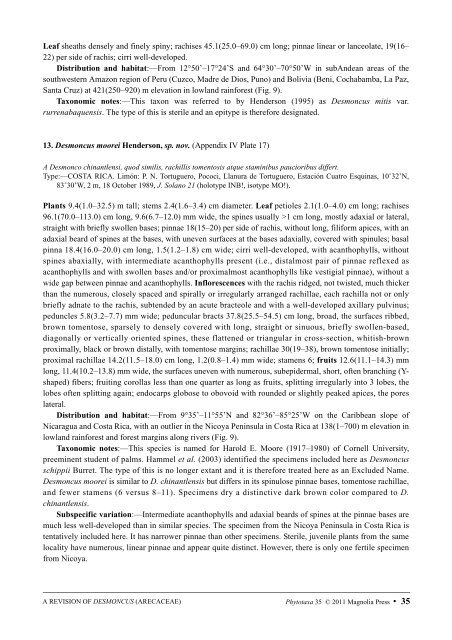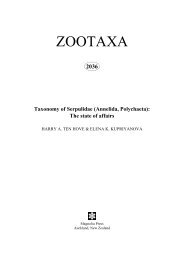Create successful ePaper yourself
Turn your PDF publications into a flip-book with our unique Google optimized e-Paper software.
Leaf sheaths densely and finely spiny; rachises 45.1(25.0–69.0) cm long; pinnae linear or lanceolate, 19(16–<br />
22) per side of rachis; cirri well-developed.<br />
Distribution and habitat:—From 12°50’–17°24’S and 64°30’–70°50’W in subAndean areas of the<br />
southwestern Amazon region of Peru (Cuzco, Madre de Dios, Puno) and Bolivia (Beni, Cochabamba, La Paz,<br />
Santa Cruz) at 421(250–920) m elevation in lowland rainforest (Fig. 9).<br />
Taxonomic notes:—This taxon was referred to by Henderson (1995) as Desmoncus mitis var.<br />
rurrenabaquensis. The type of this is sterile and an epitype is therefore designated.<br />
13. Desmoncus moorei Henderson, sp. nov. (Appendix IV Plate 17)<br />
A Desmonco chinantlensi, quod similis, rachillis tomentosis atque staminibus paucioribus differt.<br />
Type:—COSTA RICA. Limón: P. N. Tortuguero, Pococi, Llanura de Tortuguero, Estación Cuatro Esquinas, 10˚32’N,<br />
83˚30’W, 2 m, 18 October 1989, J. Solano 21 (holotype INB!, isotype MO!).<br />
Plants 9.4(1.0–32.5) m tall; stems 2.4(1.6–3.4) cm diameter. Leaf petioles 2.1(1.0–4.0) cm long; rachises<br />
96.1(70.0–113.0) cm long, 9.6(6.7–12.0) mm wide, the spines usually >1 cm long, mostly adaxial or lateral,<br />
straight with briefly swollen bases; pinnae 18(15–20) per side of rachis, without long, filiform apices, with an<br />
adaxial beard of spines at the bases, with uneven surfaces at the bases adaxially, covered with spinules; basal<br />
pinna 18.4(16.0–20.0) cm long, 1.5(1.2–1.8) cm wide; cirri well-developed, with acanthophylls, without<br />
spines abaxially, with intermediate acanthophylls present (i.e., distalmost pair of pinnae reflexed as<br />
acanthophylls and with swollen bases and/or proximalmost acanthophylls like vestigial pinnae), without a<br />
wide gap between pinnae and acanthophylls. Inflorescences with the rachis ridged, not twisted, much thicker<br />
than the numerous, closely spaced and spirally or irregularly arranged rachillae, each rachilla not or only<br />
briefly adnate to the rachis, subtended by an acute bracteole and with a well-developed axillary pulvinus;<br />
peduncles 5.8(3.2–7.7) mm wide; peduncular bracts 37.8(25.5–54.5) cm long, broad, the surfaces ribbed,<br />
brown tomentose, sparsely to densely covered with long, straight or sinuous, briefly swollen-based,<br />
diagonally or vertically oriented spines, these flattened or triangular in cross-section, whitish-brown<br />
proximally, black or brown distally, with tomentose margins; rachillae 30(19–38), brown tomentose initially;<br />
proximal rachillae 14.2(11.5–18.0) cm long, 1.2(0.8–1.4) mm wide; stamens 6; fruits 12.6(11.1–14.3) mm<br />
long, 11.4(10.2–13.8) mm wide, the surfaces uneven with numerous, subepidermal, short, often branching (Yshaped)<br />
fibers; fruiting corollas less than one quarter as long as fruits, splitting irregularly into 3 lobes, the<br />
lobes often splitting again; endocarps globose to obovoid with rounded or slightly peaked apices, the pores<br />
lateral.<br />
Distribution and habitat:—From 9°35’–11°55’N and 82°36’–85°25’W on the Caribbean slope of<br />
Nicaragua and Costa Rica, with an outlier in the Nicoya Peninsula in Costa Rica at 138(1–700) m elevation in<br />
lowland rainforest and forest margins along rivers (Fig. 9).<br />
Taxonomic notes:—This species is named for Harold E. Moore (1917–1980) of Cornell University,<br />
preeminent student of palms. Hammel et al. (2003) identified the specimens included here as Desmoncus<br />
schippii Burret. The type of this is no longer extant and it is therefore treated here as an Excluded Name.<br />
Desmoncus moorei is similar to D. chinantlensis but differs in its spinulose pinnae bases, tomentose rachillae,<br />
and fewer stamens (6 versus 8–11). Specimens dry a distinctive dark brown color compared to D.<br />
chinantlensis.<br />
Subspecific variation:—Intermediate acanthophylls and adaxial beards of spines at the pinnae bases are<br />
much less well-developed than in similar species. The specimen from the Nicoya Peninsula in Costa Rica is<br />
tentatively included here. It has narrower pinnae than other specimens. Sterile, juvenile plants from the same<br />
locality have numerous, linear pinnae and appear quite distinct. However, there is only one fertile specimen<br />
from Nicoya.<br />
A REVISION OF DESMONCUS (ARECACEAE)<br />
Phytotaxa 35 © 2011 <strong>Magnolia</strong> <strong>Press</strong> 35
















